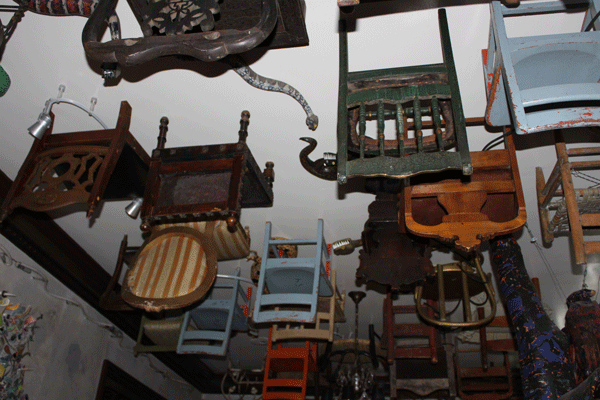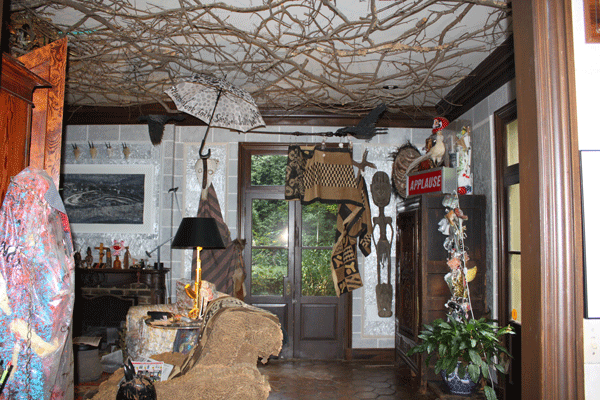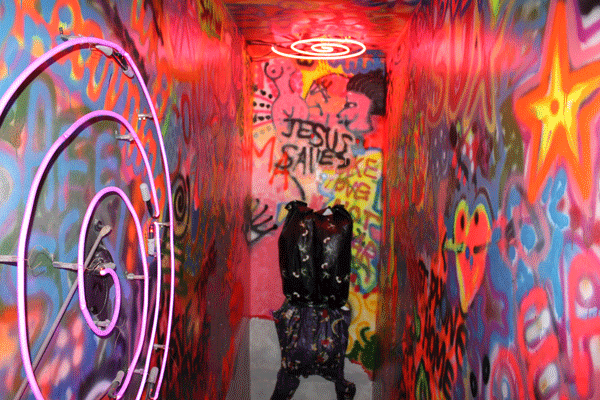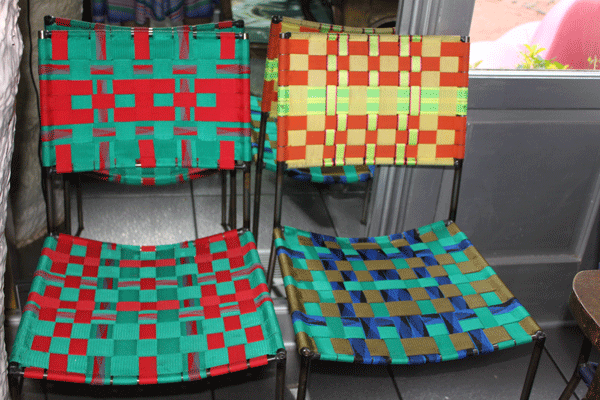-
Margot Wade’s Cabinet of Curiosities
by Margaret Eby August 2, 2010

The Wades' dining room. Carolyn made the chandalier; the ghostly figure seated at the table was part of Margot's fall show. Photo: M. Eby
“Museums are places where art goes to die,” Alan Watts once opined in Artforum, and he’s hardly the first art-lover to think so. Many contemporary artists have frought relationships with museums as institutions: No matter that great works are collected and cared for, no matter that landmark sculptures and paintings are impeccably preserved in temperature-controlled room, protected from camera flashes and finger oils by watchful guards, something about the museum forever alters the interaction between the art and the public. Les Demoiselles D’Avignon, viewed alongside the works of Van Gogh and Matisse, doesn’t have quite the revolutionary spark that it did in the salons of Paris. In the stifled atmosphere of the museum—don’t sit on this, don’t touch this, don’t speak that loudly—things begin to acquire a certain glazed over look; the life-force ebbs out of them. In 1961, pop artist Claes Oldenburg wrote a manifesto that neatly articulated the frustrated relationship he and his contemporaries had with the museumification of art:
I am for an art that is political-erotical-mystical, that does something other than sit on its ass in a museum. I am for an art that grows up not knowing it is art at all, an art given the chance of having a starting point of zero… I am for the art of underwear and the art of taxicabs. I am for the art of ice-cream cones dropped on concrete. I am for the majestic art of dog-turds, rising like cathedrals… I am for the art of things lost or thrown away
Integrating this interactive element of art into the museum space has been one of the challenges of curators of modern art museums, the brass ring institutions like MOMA and the Brooklyn Museum are leaping for.

The entranceway ceiling, dotted with snakes and chairs. Photo: M. Eby
But how do you construct a museum without the attendant effects of museumification? Birmingham-based artist Margot Wade discovered an elegant solution to this paradox: Keep living in the art. Wade, a recent graduate of Mount Holyoke, is turning her grandparents’ house into a museum, one that’s partially dedicated to her grandparents’ impressive art collection and partially a monument to her family history. Robin and Carolyn Wade will continue to live in the house and admit curious museum-goers twice or three times a week, who will take an audio tour through the house and hear family anecdotes. Margot decided to go easy on the art history because, well, it’s just not as interesting as the way her family has interacted with the art. Take, for example, the Santa Claus-shaped chocolate butt plug her grandparents have in their collection. “We could talk about the artist’s intentions,” Margot said, “or we could talk about my uncle’s reaction when we were all eating dinner with a chocolate butt plug on the table.” Another chestnut is about a human skull that Carolyn brought home on one of her expeditions after bargaining with cannibals. At one of the Wades’ parties, a guest unwittingly used it as a bowl for dip, much to Carolyn’s horror.

The Wades' den. Photo: M. Eby
Clearly, this is no ordinary grandparents’ house. Robin and Carolyn Wade’s house has been a point of local curiosity since they began collecting art in the 1980s, eventually allowing local artists free reign in various rooms. When you arrive at the house, you’re greeted by what looks like a gargantuan mechanical spider and a couch shaped like a pair of lips; the ceiling of the entrance hall is covered in upside-down chairs and painted Styrofoam snakes. The kitchen ceiling is encrusted with twisted pots and pans; above the garage a series of mannequins writhe under pink insulation paint. (That piece, called Crime Scene, originated when the garage had a leak and Robin and Carolyn liked the way the insulation looked. At night, lights illuminate the “bodies,” which look to be trying to escape from the roof..) Every possible nook of the house is stuffed with artwork, curiosities, mementos from traveling, and photographs of the Wade family.”People used to drive up and just ask to see the house,” Margot said. “I’ve had to give so many tours; I know what story goes with what piece.” Some of the artwork has attachable “penis flaps” to obscure genitalia for more conservative visitors. I had been in the house before—Margot is a high school friend of mine, and Robin and Carolyn generously hosted many art class field trips—but as Margot gave me a tour of the museum-in-progress, it was difficult to focus on any one part of the house. Here was a garage full of stuffed animals Robin had bagged over many years, here was a Kiki Smith drawing next to a series of paintings by Carolyn’s art class, here was a Rauschenberg drawing hanging along the staircase, here was a Franz West chair people actually use for sitting in, here was an enormous stuffed bear next to a coat so angular it would make Lady Gaga blush. The effect is dizzying, even before you get up to the attic crammed full of art and art materials.

Steps leading to the attic. Photo: M. Eby
“My grandparents are packrats,” Margot explained, “They save everything. So when I first started to go through all this, a year ago, the attic was so full of boxes that I had to just start making little rat trails into it.” At one point, Margot had to throw boxes of Christmas ornaments out the window, since the struggle to get back down the attic stairs seemed impossible. The treasures she excavated are an antiquities specialists dream: safety goggles, lighting fixtures, dusty leather-bound ledgers, linens, porcelain figures, a cabinet full of 1950s hardback books and animal skins, bags of newspaper clippings, needlework, accidental and on-purpose action paintings, maps of the world, hand-made lace, bejeweled insects, ball gowns, scraps of wallpaper, suitcases, a pile of mannequin parts, NRA badges, dessicated black-eyed peas, and paint long ago turned to powder. When the museum is done, Margot will display some of these alongside the art work; she plans to make the attic into a “white cube” where people can watch recordings of themselves looking at the art downstairs, a wink to the museum culture that Margot is pitting herself against.

A pair of Franz West chairs, for sitting. Photo: M. Eby
When the museum opens, it will be a combination of folk art and high art, a family cabinet of curiosities that combines the wonder of your grandparents’ attic with the experience of seeing a famous work of art. “It’s my favorite collection, and people need to know that we have this in Birmingham. We have Louise Bourgeois, and a Frank Gehry chair, and Kiki Smith.” But it’s also about everyday treasures, Margot said. “It’s about finding something and saying, look, Grandaddy, I found this picture you’ve been looking for for 30 years. It’s a memorial, monument, and museum. But it’s also the ultimate way to say ‘thank you.’”

